INTRODUCTION
Knowledge about the planets of the Solar System is the basis of the curriculum about astronomy in elementary school. Pupils learn the essential information about planets, their number, names, order from the Sun in their lessons of science. They also learn about the consequences of plan-ets’ motion in the topics of day and night alternation, season changes and Moon phases. More detailed information is later the content of the subjects geography and physics in middle school. Here pupils will understand the essence of the eclipse of the Sun and the Moon, the cause of the origin of Moon phases and other astronomical phenomena related to their basic physical and chemical characteristics and with the types of motions of planets and their moons.
The Planets of the Solar System
Planets
Since antient times people have observed the sky and pondered how the universe is organized. The first important finding was that besides the stars moving in the sky the same way which were, for a better orientation, organized in groups called constellations, there are also stars which move differently: they change their position in relation to other stars, they wander from one constellation to another as if they could not find their home. Greeks called these stars wandering stars or planets (in Greek planètes means wandering), and in the 19th century they were called bludice (wanderers) in old Czech. At the beginning, the number of the known plan-ets was rather small, it was only Mercury, Venus, Mars, Jupiter and Saturn. The Earth was included in the planets as late as at the turn of the 16th and 17th centuries. Later, planets observed by binoculars were added, e. i. Uranus (1781) and Neptune (1846). Between the years 1801 and 1807 more objects located between Mars and Jupiter: Ceres (1801), Pallas (1802), Juno (1804) and Vesta (1807) were added to the group of planets. These objects are smaller (the biggest of them, Ceres, is only slightly smaller than 1,000 km), and therefore were called “minor planets”. In the middle of the 19th century John Herschel suggested to divide “wandering objects” into planets, minor planets and asteroids but his idea was only realized as late as at the turn of the 19th and 20th centuries. At that time there were almost 500 known minor planets and the situation was chaotic. The next shift was connected with the current dwarf planet Pluto which was discovered as a planet in 1930 but was excluded from the family of planets during the 2006 astronomical congress of the International Astronomical Union basically for the same reason as had been excluded a group of small objects between Mars and Jupiter about one hun-dred years before. This time the reason for exclusion (actually a shift to a newly created cate-gory of dwarf planets) was the fact that at the turn of the 20th and 21st centuries more and more new objects appeared behind the trajectory of Neptune and the number of potential planets was again growing.
Division of Planets
According to their physical and chemical characteristics, planets are divided into two main groups. Rocky (or terrestrial) planets are Mercury, Venus, Earth and Mars, giant (or also gas, non-terrestrial) planets are Jupiter, Saturn, Uranus and Neptune.

Five dwarf planets recognized by the International Astronomical Union:
• Ceres (a photograph from the space probe Dawn)
• Pluto (a photograph from the space probe New Horizons)
• Eris and its moon Dysnomia (a photograph from the Hubble space telescope)
• Makemake and its so far unnamed moon S/2015
(a photograph from the Hubble space telescope)
• Haumea and its two moons Namaka and Hi’iaka
(a photograph from the Hubble space telescope)
(source https://en.wikipedia.org/wiki/Dwarf_planet)
Rocky Planets
The basic characteristics of the rocky planets are mainly:
• solid surface
• high density
• small size
• small flattening
• shorter distance from the Sun
• low number of moons
• absence of rings
• slow rotation
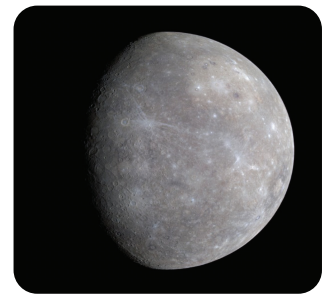
Source: https://upload.wikimedia.org/wikipe-dia/commons/thumb/d/d9/Mercury_in_color_-_Prockter07-edit1.jpg/800px-Mercury_in_color_-_Prockter07-edit1.jpg
Mercury
The closest to the Sun is the planet Mercury. This planet is smaller than Earth. At first glance it is similar to the Moon orbiting the Earth. As other rocky planets or the Moon, Mercury also has solid rocky surface on which the most noticeable features are craters. The largest crater on Mercury is Caloris with a diameter of 1,300 km. Inside the crater Caloris, there are many smaller craters. Some craters on Mercury are named after famous artists, writers and composers. Famous Czech composers Smetana, Dvořák and Janáček have their craters there too. No craters are named after Slovak or Bulgarian famous artists. Craters on Mercury were created the same way as craters on other objects of the Solar System. Their formation is caused by collision with a smaller object. When such object lands, a huge amount of heat is released. Thus, the falling object and the planet heat up to the temperature of several thousand kelvins. The rock sublimes and a basin – crater is formed. Rock located further from the object’s falling point only melts and permanently deforms. Rock even further from the object’s falling point is deformed only temporarily. Virtually no atmosphere is important for craters to be formed on Mercury. Thus, even very small objects from the outer space can land on the surface of a planet and cause formation of really small craters. In general, density and size of craters formed this way demonstrate that there is no atmosphere on the planet and at the same time there are no processes transforming the surface of the planet. Landing of an object is called impact, thus craters formed by this process are called impact craters. The largest impact craters have a central mound in the middle of them. We can watch a process of impact crater formation for example when we throw a stone into mud or a chunk of butter into semolina pudding.
The most detailed images of Mercury’s surface were taken by the spacecraft Messenger in the late 2000’s. Mercury orbits the Sun once in 88 days, e. i. in less than 3 months. The rotation period is less than 60 days, e. i. approx. 2 months. This means that Mercury rotates around its axis very slowly. Thus, days and nights on Mercury are much longer than on Earth. The Sun on Mercury rises always after 176 Earth days, for 88 days in a row it is above the horizon, for 88 days in a row it is below the horizon. Since the axis of Mercury is perpendicular to the plane of rotation, there is no change of seasons as we know them on Earth. On the side facing the Sun, Mercury is heated up to the temperature higher than 400 °C, on the obverse side it is icy with almost–200 °C.
Mercury with its radius 2,440 km orbits the Sun at a distance of about 40% of Earth’s distance from the Sun. That means that in the sky it will never get too far from the Sun. Therefore, it is only possible to see it just before sunrise or just after sunset.
Mercury is named after the Roman god of commerce and profit Mercurius. His Greek counterpart was Hermes, the god of travellers, traders and thieves. In the past old Czech names Dobropan and Horana were used for Mercury.
Venus
Venus is also a rocky planet. Venus is only slightly smaller than Earth, so it could be the Earth’s “sister planet”. However, that is not true as Venus is surrounded by dense atmosphere which does not allow to observe, in visible radia-tion from space, any surface features. We only know them from the Magellan spacecraft images (the space probe was named after Portuguese ex-plorer and navigator Fernão de Magalhães whose ship was the first to circumnavigate the Earth in 1522). The spacecraft mapped the surface of the planet by a radar in the early 90’s of the last cen-tury. The Magellan spacecraft orbited Venus on its polar trajectory (it travelled above both poles of the planet) and with the radar it took images of Venusian surface. The whole surface was mapped while the planet was rotating around its axis. It was found that the Venusian surface was resurfaced by intense volcanic activity. Although none of the volcanos on Venus are cur-rently active there are significant lava fields in their surroundings. The highest extinct volcano on Venus is Maat Mons, being about 8 km high. Other types of extinct volcanos are arachnoids and circular rings (or coronae). Circular rings are extinct volcanos with a diameter of about 20 – 25 km which partially depressed into softened surface. There are much fewer craters on Venus than on Mercury. Smaller craters are missing since small objects completely burn down when flying through the dense atmosphere. Craters are named after famous women; one of the craters is called Němcová after the female writer Božena Němcová, another one is called Cori named after Czech-American female biochemist (Gerty Cori), another crater is called Budevska after Bulgarian actress (Adriana Budevska). Some craters have Czech and Slovak first names Hanka, Julie, Vlasta, Jitka, Bulgarian first names Galina, Radka, Vaka and Zdravka.
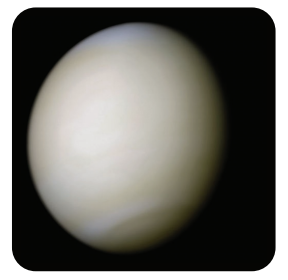
https://upload.wikimedia.org/wikipedia/commons/e/e5/Venus-real_color.jpg
Venus has several times denser atmosphere than Earth. Venus’ atmosphere consists mainly of carbon dioxide which prevents the heat leakage from the planet to its surroundings. Thus, the planet’s surface temperature reaches almost 500 °C. The increase of air temperature caused by this phenomemon is called greenhouse effect. Venus’ greenhouse effect is most significant of all objects of the Solar System. Dense atmosphere on Venus causes constant dusk. Visitors to Venus would have no chance to observe through its atmosphere the Sun or other stars..
Venus is only slightly smaller than Earth (Venus’ radius is 6,050 km, Earth’s radius is 6,400 km) and it orbits the Sun at a distance of three quarters of Earth’s distance from the Sun. Venus orbits the Sun in about 7.5 months. One year on Venus is thus slightly longer than Earth’s half year. Since Venus rotates about its axis very slowly, a day and night alternation happens only once in 117 Earth days. Venus rotates about its axis the opposite direction as Earth and most other planets. Thus, the Sun rises there in the west and sets in the east.
Venus is named after the Roman goddess of beauty. Her Greek counterpart was Aphrodite, the goddess of love. In the past old Czech name Krasopaní (Beautylady) was used for this planet.
Mercury and Venus have, when observing from Earth, similar phases to our Moon. The shape and size of the phases depend on the mutual position of the planet, the Sun and Earth.
Mars
The third planet similar to Earth is Mars. Mars has also rocky surface but it is smaller than Earth. There are very significant polar caps around both poles of Mars. They are formed by water ice and by frozen carbon dioxide (dry ice). Planet Mars is the most frequent target of spacecrafts. The spacecrafts have mapped Mars’ surface and detected that the northern hemi-sphere has lower „sea level“, while the southern hemisphere is formed by vast highlands. Red-dish appearance of Mars’ surface is caused by iron oxide.
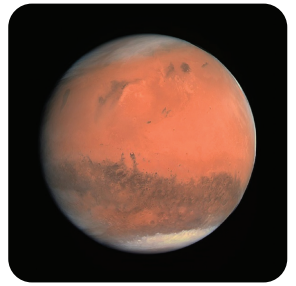
Source: https://upload.wikimedia.org/wikipe-dia/commons/thumb/0/02/OSI-RIS_Mars_true_color.jpg/800px-OSI-RIS_Mars_true_color.jpg
The research has revealed that long time ago there was enormous amount of flowing water on Mars and probably also some sea or a vast ocean. However, nowadays the planet is torrid, dry.
Water is present on Mars only in the form of snow and ice in the polar caps or as snow and frost in the deep craters. Liquid water could be found only in deep subsurface of Mars. Craters on Mars are named after scientists and towns. Slovak towns Handlová and Lipany, Czech towns Cheb, Nýrsko (crater Njesko) and Tábor have their craters as well as Bulgarian Byala and Du-lovo.
An interesting feature on Mars is the canyon Valles Marineris. The canyon is 5 – 6 km deep, several hundred kilometres wide and 4,000 km long. Close to it are the highest volcanos on Mars which, as Venus’ volcanos, are not currently active. The highest ever volcano and moun-tain on Mars is shield volcano Olympus Mons, which covers an area equivalent to the size of the Czech Republic and it is 21 km high. This height makes the volcano the highest mountain in the whole Solar System. Mars orbits the Sun in about 1.9 years. Mars’ rotational axis has almost the same inclination as Earth’s rotational axis. That means there are season changes on Mars similar to those on Earth. Mars is similar to Earth also in the period of rotation about its axis. One day on Mars lasts 24 hours and 37 minutes. The radius of the planet Mars (3,400 km) has about a half of Earth’s radius and Mars orbits the Sun 1.5 times further than Earth. The atmosphere on Mars consists mainly of carbon dioxide as atmosphere on Venus. However, Mars’ atmosphere is thin, thus the impact of greenhouse effect is much smaller.
When watched in the sky, Mars has a typical reddish colour. Hence, it was named after the Roman god of war. His Greek counterpart was Ares. In the past, old Czech names Smrtonoš and Řeřana were used.
(source: https://en.wikipedia.org/wiki/Mars)
Mars is often connected with possible life. The similarities of physical conditions on Mars and Earth have definitely contributed to the idea; moreover, throughout history there have been several waves of interest in Mars as the second “inhabited” planet. Probably the greatest interest came when Italian astronomer Giovanni Schiaparelli observed Mars in 1877, as well as after his subsequent observations of the planet. Schiaparelli registered on Mars a dense network of linear features which he called canals (Italian canali). At that time two giant canals were being built on Earth: Suez Canal and Panama Canal and their development was, in the second half of the 19th century, considered the peak of technology on Earth. With their 193 and 82 kilometres they however could not be compared with the linear features on Mars and thus, Schiaparelli legitimately assumed that civilization on Mars must have been much further in its development. Next wave of interest in Mars appeared when a ‘human face’ was photographed by the space-craft Viking in 1976. Although it is just a weathered rock with an interesting shape as has un-questionably been proved by a photograph from the spacecraft Mars Global Surveyor taken in 2001. The photograph increased the interest of people in exploration of Mars and subsequently led to a number of launched exploration spacecrafts.
There are two moons orbiting Mars: the bigger Phobos [fobos] and the smaller Deimos [dejmos]. These are rocky objects with irregular shape. Phobos is a 25-kilometre big piece of rock which orbits Mars at a distance 9,000 km. Deimos is almost a half-size of Phobos and orbits Mars at a distance 24,000 km. Even these moons – Phobos and Deimos – had their old Czech names Strach and Hrůza (Fear and Horror).
Earth
Earth, of course, belongs to the rocky planets. Its description is usually not included in the subject of astronomy but mainly in geography. Despite this, there are numerous images of Earth taken from space. Earth is regularly photographed from its orbit, as well as it is photographed from spacecrafts which can try out their cameras and take images of Earth right after their launch. Earth is the only planet (to be exact – the only known planet) with water in liquid state on its surface. Liquid water is the key factor for the origin and maintenance of life on Earth. Hence, we assume that life on other astronomical objects can be based on similar (water) processes and it is the reason why searching for water in the universe is such an im-portant topic for us.
(source: https://en.wikipedia.org/wiki/Earth)
Moon
Moon is also a rocky object being also the only moon orbiting Earth. Moon is a huge object, its radius is about four times smaller than Earth’s radius. Like some moons of giant planets, it has synchronous rotation, e. i. observers from Earth can only see one hemisphere of Moon. Synchronous rotation or tidal locking is caused by tidal forces which after a long enough period “parks” the moon in such a position that the orbital period equals the rotation period. We can observe the synchronous rotation in a perfect appearance between the pair of astronomical ob-jects Pluto – Charon. Since both objects have tidal locking, Pluto and Charon are positioned to each other with the same hemispheres like two people in love constantly looking at each other. As mentioned above, Moon as well as Mercury does not have any atmosphere. Both the astro-nomical objects look alike in photographs as impact craters are also a typical feature on surfaces of both of them.
Gas Giant Planets
The basic characteristics of gas giant Planets are mainly:
• gas “surface”,
• low density,
• relatively big radius,
• small flattening,
• longer distance from the Sun,
• numerous moons,
• presence of rings,
• fast rotation.
Jupiter
The biggest planet of the Solar System is Jupiter. Unlike Earth, Mercury, Venus and Mars, Jupiter does not have a solid surface. It is a gas planet, formed mainly by hydrogen and helium and thus the planet rotates around its axis differently from the planets with a solid surface. Besides regular research of the composition and structure of Jupi-ter’s atmosphere, in 1994 astronomers had a pos-sibility to include gradual influence of individual fragments of the comet D/1993 F2 Shoemaker-Levy 9 in their research.
It is possible to see bands parallel with the equa-torial on Jupiter already in a small telescope. Gas in individual bands circulates in different speed, in some bands it even circulates the opposite direction. In gas vortices are created in the spots where individual bands meet. The largest vortice is called Great Red Spot and has been persis-tent on Jupiter for some hundreds of years. It is slightly larger than Earth. Jupiter orbits the Sun 5.2 times further than Earth. The planet’s radius is 71,500 km, e. i. it is approximately ten times bigger than Earth’s radius.
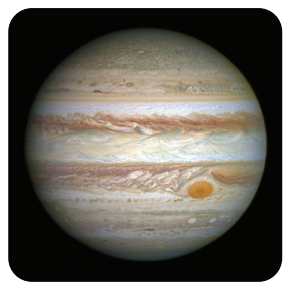
(source: https://upload.wikimedia.org/wikipedia/commons/thumb/2/2b/ Jupiter_and_its_shrunken_Great_Red_Spot.jpg/800px-Jupiter_and_its_shrunken_Great_Red_Spot.jpg)
Jupiter is named after the Roman supreme god. His Greek counterpart was Zeus. In the past, old Czech names Králomoc and Prúhana were used.
(source: https://en.wikipedia.org/wiki/Jupiter)
Jupiter is named after the Roman supreme god. His Greek counterpart was Zeus. In the past, old Czech names Králomoc and Prúhana were used.
There are numerous moons orbiting Jupiter. In 2019 we know 79 moons. The four biggest moons Io, Europa, Ganymedes and Callisto, which are visible also in smaller telescopes, were discovered by Galileo Galilei in 1610. Hence, they are called Galilean moons. All four Galilean moons orbit Jupiter in its direction. This is not a rule with other Jupiter’s moons. Many moons orbit against the planet’s rotation. The size of the smallest moons is only about 1 km. Io is a rocky object with a very turbulent volcano activity. Spacecraft Galileo has discovered here around 300 active volcanos. Europa is an object with icy surface under which there is saltwater in liquid state – an ocean. Ganymedes is the biggest moon in the Solar System, it is bigger than Pluto and Mercury. It is an icy object. Callisto is also an icy moon. There are numerous craters on its surface. Since the density of craters on objects of the Solar System enables to estimate the age of a moon’s surface as well as if the surface was later transformed by volcanic or tec-tonic activities or by erosion, it is obvious that the surface of Callisto is very old.
Besides moons there are also much smaller objects orbiting Jupiter. They orbit in a system in the plane of the planet’s equatorial and they form – when seen from a distance – the Rings of Jupiter. Some smaller moons also orbit in the area of rings and they cause ring boundaries and gaps. In the spots where shepherd moons are present, closest boundaries are billowy. This is a consequence of gravitation action of the shepherd moons.
Although it is bigger, Jupiter rotates faster than Earth, it makes one rotation about its axis in somewhat less than 10 hours. It orbits the Sun in 12 years.
Saturn
The second biggest planet of the Solar System is Saturn. It is just slightly smaller than Jupiter and orbits the Sun twice as far as Jupiter. Like Jupiter, Saturn is formed mainly by hydrogen and helium and it does not have a solid surface. Thus, Saturn also has bands in its atmosphere parallel with the equatorial. Saturn is famous for its rings. They are so prominent that they can be seen from Earth with smaller telescopes.
On closer inspection, gaps appear in the rings dividing the rings into individual ringlets. These gaps are caused by motion of bigger objects in the rings. The widest gaps are caused by moons as big as 100 km. These moons collect rings’ objects which deviate from the orbit. That way they maintain the rings’ or ringlets’ boundaries. Hence, their name shepherd moons. On the contrary, most loose parts of shepherd moons often detach from them and refill rings. Since they add up in rings from inside of the object and from outside from the other side, they have a very interesting appearance of conglomerates in the shape of section signs.

(source:https://upload.wikimedia.org/wikipedia/commons/thumb/c/c7/Saturn_during_Equinox.jpg/1280px-Saturn_during_Equinox.jpg)
Saturn’s biggest moon is Titan. Titan was discovered as early as in 1655 by Dutch physicist and astronomer Christiaan Huygens. Titan has dense atmosphere, so until re-cently we did not know what its surface is like. With the help of the spacecraft Huy-gens we know now that on the surface there are bright elevations from ice and dark valleys and riverbeds. At temperature around -100 °C it is impossible for water to flow there. The rivers and lakes are from methane which can exist in Titan in all three states. Hence, we talk about – methane circulation on Titan – a parallel of water circulation on Earth. In the future, the exploration of Titan will apparently bring new and interesting information from the point of view of life origin, as the atmosphere is, like on Earth, mostly formed by nitrogen but it is denser.
(source: https://en.wikipedia.org/wiki/Saturn)
Besides Titan and shepherd moons, dozens of other moons orbit Saturn. In 2019 we know 62 moons. Names of Nordic deities are used to name them. Most Saturn’s moons have, like moons of Jupiter, surface formed mainly by ice. Such a moon is for example the 500-km big Enceladus. In the first decade of the 21st century the spacecraft Cassini discovered eruptions of gas and icy particles up to the height of 1,500 km on this moon. Hyperion is also an interesting moon. It is Saturn’s moon with the size of about 200 km x 250 km x 350 km. It is formed mainly by ice inside of which are numerous pores. Thus, the surface is very rugged and there are very steep slopes virtually all over the moon. Saturn orbits the Sun 10 times further than Earth. The planet’s radius is 60,300 km. The Saturn’s rotation period is about the same as that of Jupiter. Axis inclination is similar to that of Earth. Saturn orbits the Sun in 30 years.
A detailed look at Saturn’s rings from the probe Cassini shows their breakdown into thin ring-lets. The ringlets are formed by numerous objects (mainly icy) with the size from 1 mm up to hundreds of metres, as can be seen in the outline. Rings fill the space from the surface of Saturn up to the distance of 500,000 km. The thickness of rings is only several hundred metres. Italian and French physicist and astronomer Giovanni Domenico Cassini, who was engaged mainly in the observation of planets, discovered in the rings of Saturn a gap that is called Cassini’s division. Axis inclination of Saturn causes that when being watched from Earth, Saturn’s rings seem to tilt. Sometimes we see them from “above”, sometimes from a “side” and sometimes from “below”.
Saturn is named after the Roman god of time. His Greek counterpart was Cronus. In the past, old Czech names Hladolet and Kruhana were used.
Uranus
The third gas giant planet is Uranus. It has a bluish colour which is a consequence of small amount of methane in the atmosphere. Uranus is also surrounded, like all other gas planets, by rings. The three biggest rings have French names Égalité, Fraternité and Liberté.
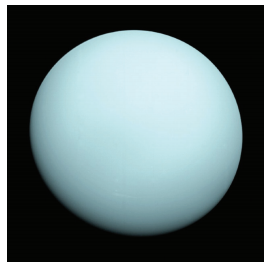
(source: https://upload.wikimedia.org/wikipedia/commons/thumb/3/3d/Uranus2.jpg/800px-Uranus2.jpg)
We know relatively little about Uranus’ moons because only one spacecraft has visited them so far – Voyager 2, launched in 1977. After its flybys of Jupiter (1979) and Saturn (1981), it was di-rected also to Uranus (1986) and subsequently to Neptune (1989). Since it was just flying by the planets it could not make images of all moons. In 2019, we so far know 27 moons. They are named after characters in works written by Shakespeare and Pope. Uranus rotates about its axis very fast, as Jupiter and Saturn, the rotation period of Uranus is 18 hours. The axis of Uranus, compared to other planets, has a unique position: it is located approximately in the plane in which Uranus orbits the Sun. Thus, the “seasons” (as well as magnetic fields around Uranus) are very complicated. Uranus orbits the Sun 19 times further than Earth. Its radius is 26,000 km.
Uranus is named after the Greek god of the universe and sky. In this respect it is an excep-tion among other planets since most planets are named after Roman gods. In the 19th century it was given also old Czech names Nebešťanka and Lehana.
(source: https://en.wikipedia.org/wiki/Uranus)
Neptune
The last gas planet is Neptune. Like Uranus, Nepture also has bluish colour caused by some amount of methane in the atmosphere.

(source: https://upload.wikimedia.org/wikipedia/commons/thumb/5/56/Neptune_Full.jpg/800px-Neptune_Full.jpg
The last gas planet is Neptune. Like Uranus, Nep-ture also has bluish colour caused by some amount of methane in the atmosphere.
Neptune too, like all gas planets, has rings. As for its moons, similarly to Uranus’ moons – we also know only a little about them. In 2019 we know 14 moons of Neptune. We have most information from the probe Voyager 2 which flew by Neptune and some of its moons in 1989. The probe exam-ined most in detail the moon Triton and discovered active volcanos on the surface of this moon. The rotation period of Neptune is 16 hours. This planet, as well as other gas planets, rotates about its axis very fast. Neptune’s axis inclination is about the same as that of Earth and Saturn and that is why its seasons are similar to those on Earth. The difference is its multiple distance from the Sun – Neptune orbits the Sun 30 times further than Earth. Its radius is 25,000 km. Neptune is named after the Roman god of sea. Its Greek counterpart was Poseidon. In the 19th century, after its discovery, it got Czech names Vodan and Šeřana.
(source: https://en.wikipedia.org/wiki/Neptune)


